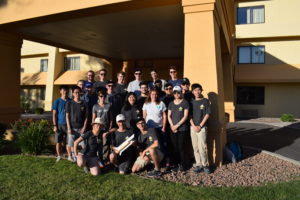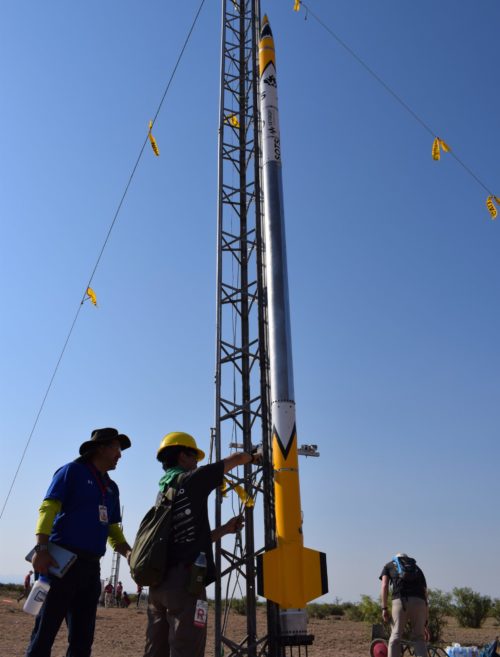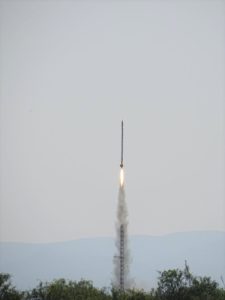Student Rocketeers Reach New Heights with Harwin
Waterloo Rocketry is a highly successful team of undergraduate rocket designers from the University of Waterloo (Ontario, Canada). The team has been successfully competing in the Spaceport America (SA) Cup for several years, and draws on many different disciplines; from mechatronics, mechanical and electronic engineering and chemistry through to nanotechnology and computing.
The annual competition is held in the desert of southern New Mexico. Academic teams develop and construct cutting-edge rockets, and bring them to the event to launch and subsequently recover them. Over 100 teams participate each year from a multitude of nations, with some competitive and longstanding rivalries that have built up over the years.

Waterloo Rocketry have an impressive record of accomplishment, and in recent years they have taken several prizes at the SA Cup. In 2017, their VIDAR II rocket came first in the 10,000 feet hybrid contest (where the rockets have a solid fuel source and a liquid oxidizer), also receiving the coveted technical excellence award. Their UXO rocket helped them to retain the 10,000 feet hybrid title in 2018, accurately reaching a target height of 13,000 feet.
In 2019 the team set their sights on a new goal, more ambitious than anything attempted before. The new rocket design had to reach a staggering height of 30,000 feet (almost 3 times that of previous rockets, around the cruising altitude of a jet airline). For the 15-foot (4.6m) tall hybrid rocket to reach such heights, the 30-person team had to totally rethink almost every aspect of the design.

As the height was so much greater, the airframe, payload, propulsion and aerodynamics all had to be considerably enhanced. More room was needed for the oxidizer and for fuel storage. The parachute also doubled in size from 2018, to ensure safe recovery from such an elevated altitude. All the rocket’s constituent components had to be more compact, to free up this additional space and be as lightweight as possible, increasing the maximum range with its limited fuel reserves. But the rocket still needed to be robust enough to cope with the stresses of launch and recovery.
The rocket engine had to deliver far greater power (around 50% more than the previous one) and the burn time at launch (to approximately 35s), with a longer period at peak intensity.
With this project, the team wanted to be able to network together all the rocket’s onboard electrical systems responsible for propulsion and monitoring key parameters while in flight. To do this they needed connectors with enough resilience to survive launch acceleration, but quick and easy to assemble with minimal tooling – as much of the assembly work is done by hand in the desert just before launch. The space constraints meant the large (5mm pitch) barriers blocks used in previous rockets were too bulky for the new design.
The team’s electrical engineers chose Harwin’s 2mm pitch Datamate J-Tek series.. The vibrational resilience to 10G for up to 6 hours and extreme temperatures of -55°C to +125°C were key factors. Made from Beryllium Copper, each contact can carry up to 3.3A, and the new ‘T-Contact’ version can carry as much as 8.5A – giving the capacity for both power and data in one compact connector.
Seven Datamate J-Tek connector pairs were incorporated into the rocket design, linking up six separate onboard subsystems. These included: the radio communication subsystem; the sensor suite; the data logging hardware (for diagnostics); a GPS receiver (to assist rocket recovery); and the two valve-driving subsystems.

“Now that the heights we are looking to achieve have increased dramatically, we’ve really had to start thinking a lot smaller when approaching the basic design concept. All the component parts must adhere to the volumetric limitations we have to deal with, and not add significantly to the rocket’s overall weight, as this would cause a reduction in range,” explains Aaron Morrison, Project Co-lead at Waterloo Rocketry. “Also, they must be sturdy enough to be able to survive the vibration and acceleration that occurs during the launch.”
“We only get one launch opportunity each year, and all the countless hours of work that all of us have put in will be simply wasted if there is a component failure. The fact that the Harwin Datamate J-Tek connectors are small and light, and at the same time very rugged means that they meet all our required criteria. This will allow us to achieve our targeted altitude and ensure that there is no risk of any malfunction occurring,” he continues. “And as positive attachment is a mandatory stipulation of the competition, the jackscrews on these connectors are a key feature.”
The SA Cup was held from 18th to 22nd June 2019, and the team took 2nd place in the category: ‘30,000ft Hybrid / Liquid & Other’. The rocket successfully flew to over 15,000 feet but the recovery system failed to deploy the main parachute, and the rocket hit the ground a little harder than expected. Fortunately, all the electronic systems onboard survived, including the Harwin Datamate J-Tek connectors.
The team are now beginning their preparations and developments for the 2020 SA Cup, including ways to improve the rocket performance and increase the reliability of the recovery system. Follow their progress on Facebook and YouTube.
Uh oh, it looks like you are using an outdated browser version.
Some functions may not work as expected on Harwin.com in your current browser. For the best experience, more security and speed, we recommend updating your browser to the latest version.
(if you are using Internet Explorer, we recommend switching to an alternative browser.)
Still having issue? Contact [email protected] for help.



